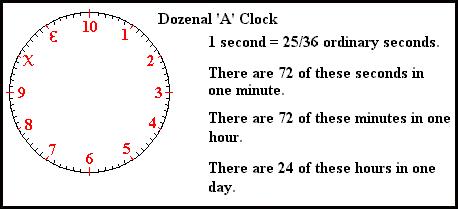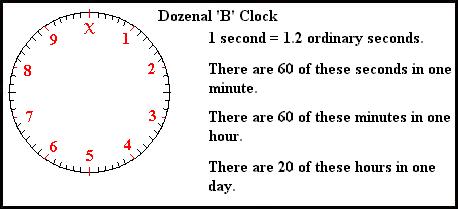Dozenal Time: Proposal for a duodecimal method of
measuring time
Originated: 25 November 2004
Revised: 07
February 2005
*
* *
If we were to
switch to a dozenal counting system as well as to a dozenal measuring
system, our clocks would have to change; it's just that simple. We were able to keep the 60-divisions circle
for our clocks in spite of counting in decimal because we use twenty-four
hours, each of which divides into twelve neat little packets of 5 divisions
(minutes/seconds) each. Some duodecimal
advocates, when discussing time, think no further than slapping two new digits
on the clock face in place of 11 & 12; but it is actually a much more
complex issue.
If we changed to
a base twelve counting system, our perception of '5' would change. It would no longer that convenient binary of
ten, our current base number. Instead,
it would be this inconvenient number that kids don't like reciting
multiplications for (imagine the multiplication table for seven; that's what
five would be like in dozenal). In any
discussion of dozenal counting, you have to remember that one dozen would be
the new 10 and six, by consequence, would be the new 5. Since it is important that calculating time
be easy for us, it is important that we concentrate on groupings of 6, 12, 72,
and 144 (in dozenal: 6, 10, 60, 100 – remember, 2 x 6 = 10 in duodecimal
multiplication). What does this mean
for time? It means that the old
60-divisions circle is going to have to be replaced; or it must
have ten divisions – these two options are mutually exclusive. In keeping with this reality, I have two
proposals (well, actually three, but the third is really just a variation of
the first, but more on that later).
My first time
scheme is also my personal preference.
I call it 'dozenal (a) time'.
There is a second variant on this that could perhaps be called 'dozenal
(a-1) time', but first things first.
Dozenal (a) will call for a clock that has 72 divisions. The day will still be 24 hours, but each
hour will have 72 minutes, and each minute 72 seconds. What does this mean for you? Hours will still be the same and time
keeping will not be constructively different than it is now. The only major difference is that the minute
and the second will be slightly shorter than what we're used to (1 dozenal (a)
minute = 50 standard seconds and 1 dozenal (a) second = 25/36 standard
seconds).
Using the
dozenal (a) second, the meter would be calculated as the distance traveled by
light in a vacuum in 18/3 747 405 725 of a second. When calculating the foot, we, of course, would want a fraction
of 1/x; and preferably a fraction that can be divided by three so we can have a
nifty 1/x fraction value for the yard like we would have for the foot and the
inch. (This is all, of course, assuming
that we used the current foot as a reference as opposed to the old U.S. survey
mile.)
Chart showing
dozenal (a) time relationships (The below text is written in decimal)
Dozenal (a)
time: 24 hr. day (clock face numbered 1-12 with 12 sets of 6 min./sec. each)(72
min./hr.; 72 sec./min.)[Differences to current clock: shorter min./sec]
|
Value in Dozenal (a) Seconds |
Dozenal (a)
Time Units |
Equivalent in Current Time Units |
Equivalent in Current Time Seconds |
|
1 sec |
1 sec |
25/36 sec |
25/36 sec |
|
72 sec |
1 min |
5/6 min |
50 sec |
|
5 184 sec |
1 hour (72
min) |
1 hour (60
min) |
3 600 sec |
|
124 416 sec |
1 day (24
hours) |
1 day (24
hours) |
86 400 sec |
Image of the
dozenal (a) clock (using dozenal characters
on the face)

Something that
annoys me (and hard core decimalists – please don't let them know that I agree)
about our current method of time keeping is the fact that the numbers roll over
to '00' after '59', not after '99' like we're used to. Our current minute/second time keeping
system is, in fact, a hybrid of our current base 10 (decimal) and old
Babylonian base 60 (sexagesimal). If we
want to avoid creating a base 72 (or base six-dozen) system for our
minute/second time keeping, we can avoid doing so by doubling the length of the
hour and halving the length of the second in dozenal (a) time. Instead of 72 (six-dozen) divisions, the
clock face would have 144 (twelve-dozen).
This would make a day of 12 hours each one of which is twice as long as
our current hour. Each hour would have
144 minutes and each minute would have 144 seconds. (144 = 100 in dozenal notation.)
That way, the counter would roll over to '00' after eleven-dozen and
eleven like we'd be used to rather than after only five-dozen and eleven
(remember that in dozenal counting, the next number after eleven is one dozen,
which looks like '10'). So, to
reiterate, the dozenal (a-1) variant shares the same length minute with dozenal
(a); the difference is that there are twice as many minutes in an hour and
twice as many seconds in a minute; also that hours are twice as long and
seconds are half as long; 1 day is only 12 hours. I really don't see this variant taking off, though because the
dozenal (a) second is already slightly shorter than a standard second; this makes
the dozenal (a-1) second a lot shorter than what is useful for the average
person. Decimal time-keeping systems
have probably been rejected in the past for similar reasons. Because I think this particular variant has
the lowest chance of adoption out of my three suggestions herein, I have not
calculated the meter or other linear measure using this second. You may if you wish. It is easy, just tedious – it's easy to see why
people might want a sexagesimal counting system; it makes big numbers easier to
handle. I also have not provided a
dozenal (a-1) clock because it would be too much trouble for me to divide a
circle into 144 parts. You are welcome
to do so if you wish, but it's easier just to look at the dozenal (a) clock and
use you imagination.
Chart showing
dozenal (a-1) time relationships (The below text is written in decimal)
Dozenal (a-1)
time: 12 hr. day (clock face numbered 1-12 with 12 sets of 12 min./sec.
Each)(144 min./hr.; 144 sec./min.)[Differences to current clock: Longer hour, shorter
min., much shorter sec.]
|
Value in Dozenal (a-1) Seconds |
Dozenal
(a-1) Time Units |
Equivalent in Current Time Units |
Equivalent in Current Time Seconds |
|
1 sec |
1 sec |
25/72 sec |
25/72 sec |
|
144 sec |
1 min |
5/6 min |
50 sec |
|
20 736 sec |
1 hour (144
min) |
2 hours (120
min) |
7 200 sec |
|
248 832 sec |
1 day (12
hours) |
1 day (24
hours) |
86 400 sec |
*
* *
My second time
scheme, while not my personal preference, does keep the 60-divisions clock face
that we currently used (of course, the similarities end there) . I call it 'dozenal (b) time'. Dozenal (b) will call for a clock that has
60 divisions (this is five-dozen, or '50' in dozenal notation). The day will have 20 hours, but each hour
will have 60 minutes, and each minute 60 seconds. What does this mean for you?
There would be no more 24 hour day, only 20. Hours, minutes, and seconds would be longer. Also, it would become more difficult to
gauge quarters of an hour since 10 doesn't divide by four (see, 12 is moree
useful after all). (1 dozenal (b)
minute = 72 standard seconds and 1 dozenal (b) second = 6/5 standard
seconds).
Using the
dozenal (b) second, the meter would be calculated as the distance traveled by light
in a vacuum in 5/1 798 754 748 of a second.
When calculating the foot, we, of course, would want a fraction of 1/x;
and preferably a fraction that can be divided by three so we can have a nifty
1/x fraction value for the yard like we would have for the foot and the
inch. (This is all, of course, assuming
that we used the current foot as a reference as opposed to the old U.S. survey
mile.)
Chart showing
dozenal (b) time relationships (The below text is written in decimal)
Dozenal (b)
time: 20 hr. day (clock face numbered
1-10 with 10 sets of 6 min./sec. each)(60 minutes/hour; 60 sec/min)[differences
to current clock: longer hours, longer min./sec]
|
Value in Dozenal (b)
Seconds |
Dozenal (b) Time
Units |
Equivalent in Current Time Units |
Equivalent in Current Time Seconds |
|
1 sec |
1 sec |
1 & 1/5
sec (or 1.2) |
1 & 1/5
sec (or 1.2) |
|
60 sec |
1 min |
1 & 1/5
min (or 1.2) |
72 sec |
|
3 600 sec |
1 hour (60
min) |
1 & 1/5
hours (or 1.2) |
4 320 sec |
|
72 000 sec |
1 day (20
hours) |
1 day (24
hours) |
86 400 sec |
Image of the
dozenal (b) clock (using dozenal characters
on the face)

*
* *
Return to Dozenal Weights and Measures
Return to Nearly Everything You Need to Know About Weights and Measures
